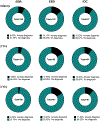Temperament and psychopathology: The "community" to which you belong matters
- PMID: 35226361
- PMCID: PMC9970029
- DOI: 10.1111/cdev.13742
Temperament and psychopathology: The "community" to which you belong matters
Abstract
We utilized a community detection approach to longitudinally (a) identify distinct groups of children with common temperament profiles in infancy and at 2 and 3 years of age and (b) determine whether co-occurrence of certain temperament traits may be early predictors of internalizing problems at 5 years of age. Seven hundred and seventy-four infants (360 girls; 88.6% White, 9.8% Hispanic, and 1.6% other races) were recruited from the Boston area. Data collection spanned from 2012 to 2021. The analysis yielded three distinct groups of children with different temperament traits and was associated with significant variation in levels of internalizing symptoms and anxiety diagnosis rate. Our findings suggest that stable temperament "communities" can be detected in early childhood and may predict risk for psychopathology later in life.
© 2022 The Authors. Child Development © 2022 Society for Research in Child Development.
Figures





References
-
- Achenbach TM, Becker A, Döpfner M, Heiervang E, Roessner V, Steinhausen HC, & Rothenberger A. (2008). Multicultural assessment of child and adolescent psychopathology with ASEBA and SDQ instruments: Research findings, applications, and future directions. In Journal of Child Psychology and Psychiatry and Allied Disciplines (Vol. 49, Issue 3, pp. 251–275). John Wiley & Sons, Ltd. - PubMed
-
- Achenbach TM, & Rescorla LA (2000). Manual for the ASEBA preschool forms and profiles (Vol. 30). Burlington, VT: University of Vermont, Research center for children, youth, & families.
-
- Ahadi SA, Rothbart MK, & Ye R (1993). Children’s temperament in the US and China: similarities and differences. European Journal of Personality, 7(5), 359–378. 10.1002/per.2410070506 - DOI

